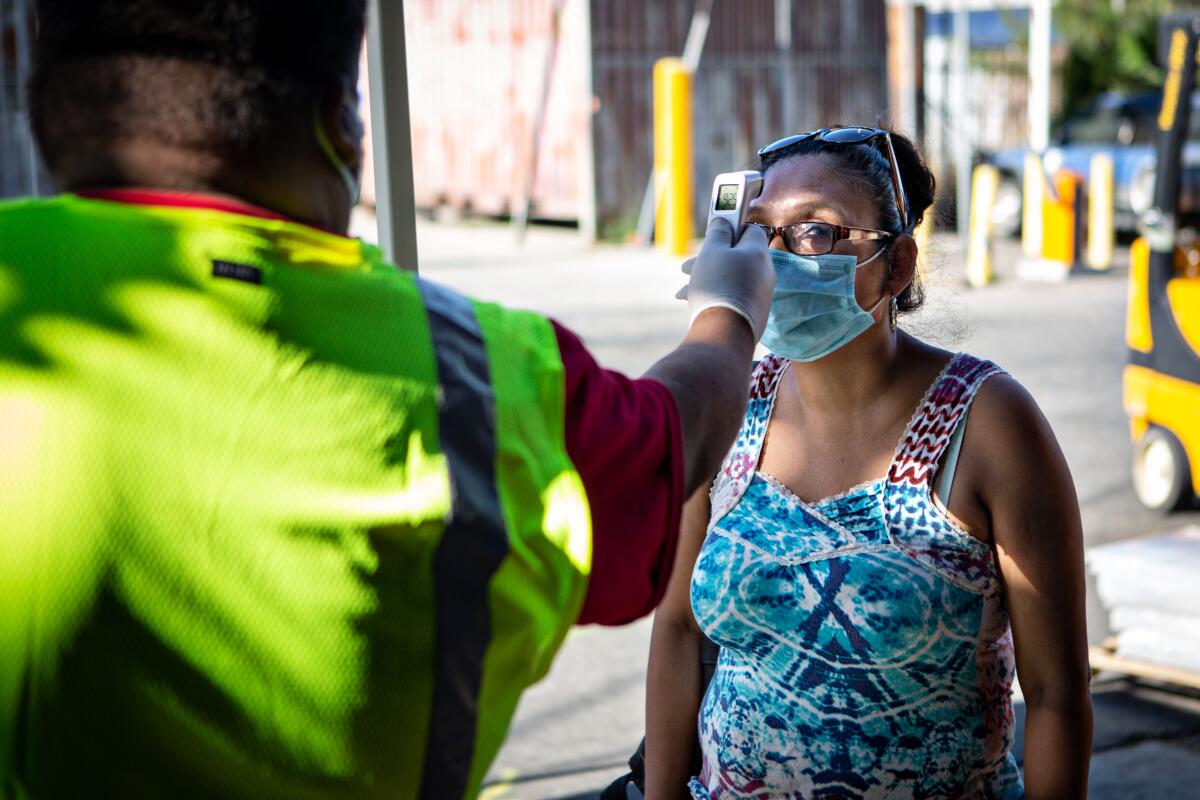Los Angeles County reports highest weekly total of new coronavirus cases

Los Angeles County saw three record-breaking single-day increases in new coronavirus infections this week and the highest number of cases logged in one week.
Surpassing 17,000 cases from last week, Los Angeles Mayor Eric Garcetti reported 23,310 new cases in the county from this week at a Friday evening briefing.
Los Angeles County public health officials reported 4,506 new coronavirus cases Thursday, shattering the record for the highest single-day increase in new infections of 4,200 from Tuesday.
“Each case represents a person that is capable of, and in all probability is, infecting at least one other person,” Barbara Ferrer, the county health director, said in a statement. “If you do the math, it is easy to see why the alarm.”
Garcetti reported 2,885 new cases and 62 deaths on Friday in the county, for a total of 150,319 positive confirmed cases and 4,047 deaths, matching the expectations from the county to surpass 4,000 deaths by the end of the week.
“The simple truth of this fight is that this virus is affecting more and more of us every day,” Garcetti said.
A similar surge was taking place across California, which has now tallied 367,561 confirmed cases of the virus and 7,524 deaths, according to the Los Angeles Times’ California coronavirus tracker.
On Tuesday, the state recorded its highest number of new cases in a single day, 11,142 infections. Tuesday also marked the second-highest number of deaths in a single day statewide, with 144 deaths tallied, according to the tracker.
“This week we’ve hit concerning milestones,” Ferrer said. “We have reported the most cases in a single day, the most hospitalizations and tragically high death numbers.”
L.A. County reported record numbers of confirmed coronavirus patients in its hospitals on Tuesday and again Wednesday. There were 2,173 confirmed coronavirus patients in county hospitals Thursday, with 27% in intensive care and 17% on ventilators.
By Friday, hospitalizations stood at 2,188 confirmed coronavirus patients.
Twenty percent of the patients are between 18 and 40, a higher share than at any other point during the pandemic, officials said Thursday.
The proportion of test results coming back positive also continues to climb, with more than 1.44 million people tested as of Thursday and 9% testing positive. An increase in the positivity rate indicates that the disease is spreading more rapidly in the community, experts say.
Officials believe the uptick in disease transmission began in late May, when more people began leaving their homes to go back to work, attend social gatherings and visit newly reopened restaurants and other establishments.
It takes up to two weeks for the virus to incubate and then another week or two for cases to result in hospitalization or death.
County health officials said earlier this week that the coronavirus is spreading rapidly in workplaces that are not following safety rules. The sectors with the highest numbers of cases are food processing and distribution facilities, including meatpacking plants, manufacturing facilities, garment factories and wholesale warehouses.
The worst local workplace outbreak occurred at Los Angeles Apparel, a garment manufacturer based in South L.A. More than 300 of the company’s nearly 2,300 employees have tested positive for COVID-19 and four have died, Muntu Davis, the county health officer, said Thursday.
The county public health department said that it first shut down operations at the garment manufacturer June 27 after inspectors found “flagrant violations” of public health infection control orders and said the company failed to cooperate with an investigation of a reported coronavirus outbreak.
The company’s founder, Dov Charney, disputed those claims and questioned whether there was evidence that the factory’s workers were being infected at a higher rate than those living in the surrounding community.
Higher mortality rates among lower-income communities and Black and Latino residents in L.A. County have remained a key concern for health officials. Deaths among Latino residents make up 60% of the fatalities that have occurred outside skilled-nursing facilities in the county, data show.
“Unfortunately, a lot of disproportionality can be traced to the fact that a significant number of essential workers are low-income or are people of color,” Davis said. “Oftentimes, people who are low-income cannot stay home to work, and early in the pandemic, there were few protections offered at many work sites.”
Officials estimate that the effective transmission rate of the coronavirus has risen slightly to 1.07, according to data released Wednesday, although the actual number could be anywhere from 0.94 to 1.2. That means officials estimate that on average, every one person infected with the virus transmits it to 1.07 other people.
In a bid to tamp down the uptick, Gov. Gavin Newsom on June 28 ordered bars closed in L.A. County and several others, followed by indoor restaurant dining on July 1.
Garcetti said Friday that he will hold off on additional closures.
It has been about two weeks since Newsom’s order, but it’ll take at least three weeks to learn whether the actions taken that week decisively changed the course of the pandemic, said Dr. Christina Ghaly, director of health services for Los Angeles County.
Ghaly said Wednesday that if people go back to safer behavior — staying home as much as possible, avoiding social gatherings, wearing face coverings, keeping physical distance and workplaces following new safety protocols — L.A. County could avoid having hospitals and ICUs overwhelmed.
Still, given the exponential nature of the virus’ growth, officials have expressed concern about the outlook in the coming days. The 4,500-plus cases identified Thursday could lead to more than 18,000 infected people “in a few weeks,” Ferrer said.
“And this is just from one day of new cases,” she said. “Without aggressive action on the part of every person, we will not get back to slowing the spread.”
More to Read
Sign up for Essential California
The most important California stories and recommendations in your inbox every morning.
You may occasionally receive promotional content from the Los Angeles Times.














